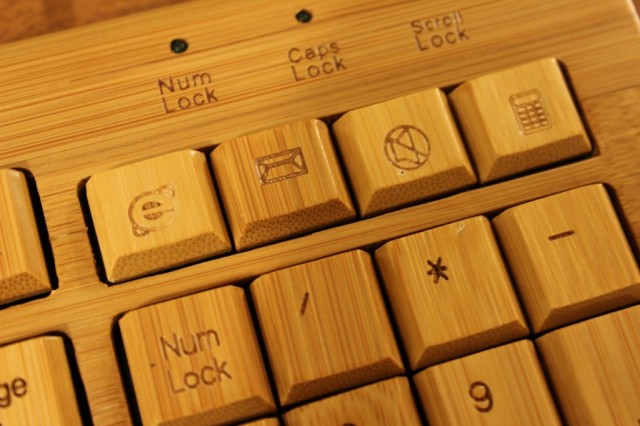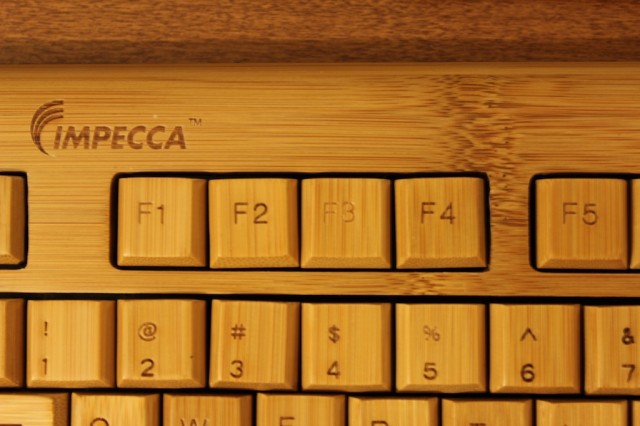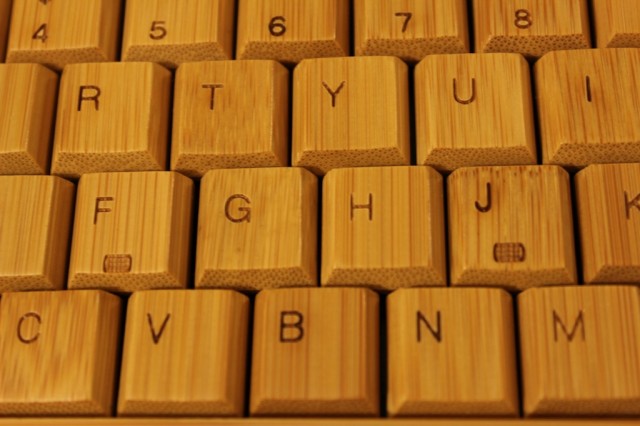
As computers, smartphones, and flatscreen televisions proliferate all over the planet, electronic waste is becoming an ever more serious problem. The US Environmental Protection Agency says that in 2009, of the 2.37 million tons of electronics that were thrown out, only 25 percent of those tons were actually recycled—and remember, this is before the new wave of tablets showed up and added millions more devices to the growing pile of tech in all our homes. Continued pushes to recycle old technology are probably the best long-term solution to this problem, but other companies are taking a more creative solution to the problem.
One of these is Impecca, whose hand-carved bamboo keyboards and mice caught our eye at Consumer Electronics Week in New York a couple of weeks back. The Impecca Bamboo KBB500 isn't entirely biodegradable—the USB cables are still plastic and metal, and the keyboard's innards are the same as any standard dome-switch keyboard. However, its casing and all of the keys are carved entirely out of bamboo, which is both biodegradable and very unique-looking in a PC keyboard. Impecca sent us a review unit so we could take it for a spin and see if its bamboo construction impacted usability.
Bamboo, but otherwise basic

Most of the keyboards I use at home and at work are Apple's chiclet-style keyboards, so it took me a little time to get used to the Bamboo's size and longer key travel distance. If you're coming from a standard PC keyboard, you'll have an easier time—the Bamboo has slightly less travel than the standard 104-key keyboard you'd get with a PC desktop these days, but otherwise it looks and feels very similar.

The wooden finish is smooth, attractive, and faintly reflective, and the wood grain gives it a very distinctive look, like something that doesn't quite belong on the same desk as a modern computer. The smoothness of the keys may be a bit odd if you're used to the lightly textured plastic of most keyboards, but after I had typed a few hundred words I became used to the keyboard and was typing at my normal rate. For me, the worst thing about the keyboard (and its single biggest sin) is the lack of a stand on its underside—I like to have the keyboard angled toward me as I type, and many keyboards are either gently slanted that way in the first place or include a kickstand on the bottom that slightly adjusts the angle. Other than some rubber feet to keep the keyboard stable on your desk, the Impecca's bottom is completely smooth, and I ended up using a stack of business cards to angle the keyboard to my satisfaction.

There's much less to say about the included mouse, which is a standard three-button optical mouse with a scroll wheel. The mouse is a bit narrow, and you can feel it if you're used to almost any other mouse—it's even a little narrower than the two Logitech travel mice I own. You notice the difference a bit when your hand is resting on the mouse, though it doesn't significantly affect usability. The mouse's finish is similarly smooth, and a blue LED lights up the scroll wheel—how you feel about it will depend on how you feel about superfluous LEDs in your electronics. 
Other than the lack of a keyboard stand, the worst thing about the keyboard and mouse combo is probably the minor inconsistencies that result from its hand-carving. You'll find that some of the keys are etched more lightly than others, making some keys harder to read than the rest. This could be a sore point for non-touch typists who have to look at the keys as they type. The lettering can also be slightly uneven—the textured indentations on the F and J keys in the home row, for example, are noticeably uneven on my keyboard. There's also a small imperfection in my mouse where the light from the scroll wheel LED shines through.

All of these blemishes are minor and superficial in nature, and they're going to vary from keyboard to keyboard—it may be that your keyboard has none of the imperfections I've listed, and it may be that the imperfections you notice are different or greater in number. Whether you view them as problems or as part of the keyboard's charm, it's something to keep in mind when buying hand-carved computer components.

The fact of the matter is that at $69.95 for the keyboard alone or $79.95 for the set, this distinctive keyboard and mouse are more notable for their looks and eco-friendliness than their amenities. There are other iterations available if you'd like to get more or spend less: for $99.99 you can get a set with a wireless USB dongle that includes a keyboard with a stand, and for $29.95 you can buy a version with a bamboo base but standard, plastic keys with more consistent printing. However, if you don't care for the wooden look or need something with better ergonomics, you'll probably want to look elsewhere for your keyboard.

The Good
- Biodegradable base and keys will cut down on electronic waste.
- Distinctive, charming hand-carved look and attractive wooden texture.
- Smooth and shiny finish that is reasonably comfortable for typing.
The Bad
- The hand carving means you may have to put up with cosmetic inconsistencies and imperfections.
- Pricey for a basic 104-key layout with few dedicated application or media buttons.
The Ugly
- No keyboard stand means you'll have to MacGyver your own out of whatever stuff you've got lying around the house, if you prefer to type at an angle.
reader comments
84